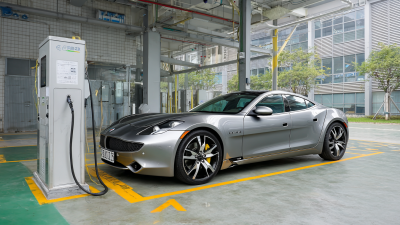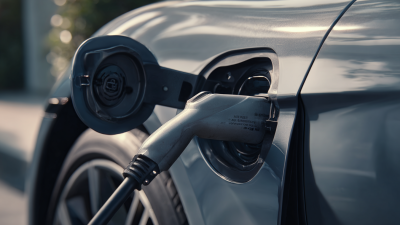
Wall Mounting EV Charge Station
Envisioning Tomorrow: How the V2L Adaptor is Shaping the Future of Electric Vehicle Connectivity
As the electric vehicle (EV) market is projected to reach a staggering 30 million units by 2025, according to recent reports by the International Energy Agency, the need for advanced connectivity solutions has never been greater. One of the most innovative advancements in this realm is the V2L Adaptor, which stands for Vehicle-to-Load technology. This capability allows electric vehicles to not only draw power from the grid but also supply energy to external devices, thereby enhancing the versatility of EVs.
 With the advent of renewable energy sources and smart home technology, the V2L Adaptor represents a pivotal step in the evolution of electric mobility, enabling owners to utilize their vehicles as portable energy sources. This blog will explore the myriad benefits of the V2L Adaptor, emphasizing its role in fostering a more interconnected and sustainable future for energy consumption.
With the advent of renewable energy sources and smart home technology, the V2L Adaptor represents a pivotal step in the evolution of electric mobility, enabling owners to utilize their vehicles as portable energy sources. This blog will explore the myriad benefits of the V2L Adaptor, emphasizing its role in fostering a more interconnected and sustainable future for energy consumption.
The Rise of Vehicle-to-Load (V2L) Technology in Electric Vehicles
The rise of Vehicle-to-Load (V2L) technology is ushering in a new era for electric vehicles (EVs), transforming them from mere transportation means into versatile energy hubs. This innovative technology allows EVs to supply power to other devices, which can be particularly beneficial in emergency situations or during outdoor activities. For instance, the recent rescue of a stranded EV on the highway demonstrated the practical utility of V2L technology, highlighting its potential to enhance the overall user experience and convenience of electric mobility.
As the electric vehicle power inverter market is projected to grow from $10.56 billion in 2025 to $25.25 billion by 2032, with a remarkable compound annual growth rate (CAGR), it signals a robust demand for advancements in EV technology like V2L. The adoption of V2L features across various models underscores a strategic shift toward integrating more advanced functionalities that appeal to modern consumers. With the integration of vehicle-to-load and vehicle-to-vehicle (V2V) technologies, manufacturers are not only improving safety through enhanced software features but also fostering a connected ecosystem where vehicles can seamlessly share resources. This marks a significant leap towards a future where electric vehicles play a pivotal role in our energy landscape.
Understanding the Benefits of V2L Adaptors for Everyday Consumers
The rise of Vehicle-to-Load (V2L) adaptors is transforming the landscape of electric vehicle (EV) connectivity, offering an array of benefits for everyday consumers. According to a report by Allied Market Research, the global V2L market is anticipated to reach $7.5 billion by 2027, with an impressive CAGR of 15.5%. This growth underscores the increasing demand for innovative EV solutions that enhance utility and convenience for vehicle owners.
One of the most significant advantages of V2L adaptors is their ability to power devices directly from the vehicle's battery. For instance, drivers can use their EV to charge laptops, power tools, and even run small appliances during camping trips or emergency situations. A study by the International Energy Agency indicates that as of 2022, over 30% of EV users reported finding additional use cases for their vehicle beyond transportation. This functionality not only improves the overall value of electric vehicles but also enhances their role as multifunctional tools in daily life.
As V2L technology continues to evolve, everyday consumers can look forward to a more integrated and sustainable lifestyle powered by their electric vehicles.
Tips for Maximizing Your Electric Vehicle's V2L Connectivity
As electric vehicles (EVs) continue to evolve, leveraging Vehicle-to-Load (V2L) connectivity has become crucial for maximizing their potential. The V2L adaptor allows EV owners to tap into their vehicle's battery power to charge external devices, making it a versatile tool for both everyday and extraordinary needs. To fully utilize this capability, users can adopt a few practical strategies.
First, consider the power demands of your devices and plan accordingly. High-demand appliances may quickly drain your EV's battery; hence, prioritizing which devices need power can extend both functionality and range. For example, using V2L to power essentials like a laptop or a camping stove while reserving battery life for vehicle use ensures that you remain connected and efficient.
Second, take advantage of your EV’s onboard apps and features that track energy consumption. Many modern EVs come with built-in systems that help monitor power usage in real-time. Familiarizing yourself with these tools allows you to balance power delivery effectively, ensuring you get the most out of your V2L adaptor while maintaining adequate charge for your journey ahead. By maximizing your electric vehicle’s V2L connectivity, you not only enhance your travel experience but also embrace a more sustainable lifestyle.
Electric Vehicle V2L Connectivity Trend
This bar chart illustrates the increasing adoption rate of V2L (Vehicle-to-Load) connectivity in electric vehicles from 2019 to 2023. As the technology becomes more prevalent, we can observe a significant rise in its utilization, indicating a promising future for enhanced electric vehicle connectivity.
Future Innovations: How V2L Will Influence Smart Home Integration
As electric vehicle (EV) technology continues to advance, the implementation of Vehicle-to-Load (V2L) technology is taking center stage in shaping smart home integration. This innovative capability allows EVs to function as portable power sources, enabling drivers to power household appliances directly from their vehicle’s battery. According to a recent report from the International Energy Agency, the adoption of bidirectional charging, including V2L systems, is expected to rise sharply, with projections suggesting that over 50% of new EVs will incorporate this technology by 2030.

The practical applications of V2L are immense, especially in scenarios such as power outages or during peak energy demands. Reports indicate that using EVs in V2L mode could significantly mitigate the impact of blackouts by supplying crucial energy to homes. An analysis by the Solar & Storage Industry Association shows that integrating V2L functionality can enhance energy resilience for households, enabling a seamless transition to renewable energy sources while optimizing costs, as homeowners can draw from their vehicle’s battery instead of relying solely on the grid. This promising synergy between electric vehicles and home energy management systems heralds a future where our cars can not only transport us but also empower our homes with clean, renewable energy.
The Role of V2L in Sustainable Energy Solutions and Grid Support
The integration of Vehicle-to-Load (V2L) technology is becoming pivotal in shaping sustainable energy solutions and enhancing grid support. With the UK's recent energy market reforms aimed at cutting grid costs significantly, the movement towards clean energy has gained substantial momentum. These reforms are expected to drive efficiencies in electrical systems, illustrating the vital role that advanced energy solutions, such as V2L, will play in managing distributed energy resources effectively.

As electric vehicle manufacturers increasingly adopt V2L technology, the potential for two-way charging systems to not only supply power back to the grid but also support local energy needs is immense. For instance, the upcoming Renault model is set to incorporate this innovative technology, providing a practical application where EVs can act as energy reserves. This alignment with emerging energy infrastructure not only promises to bolster grid reliability but also presents an opportunity for consumers to participate actively in energy conservation strategies, thereby reducing overall emissions and fostering a sustainable environment. Reports indicate that the increased adoption of V2L and related technologies could lead to a market growth projection exceeding $15 billion by 2025, underscoring its transformative impact on energy landscapes globally.
Related Posts
-

5 Reasons Why the Ac V2L Cable is the Best Choice for Electric Vehicle Charging in 2023
-

Embracing Innovation: The Future of EV Charger Stations for Sustainable Transportation
-

2025 Trends Revealed 7 Key Innovations in Best Ev Charger Technology
-

Challenges Encountered with Ac V2l Cable in Electric Vehicle Charging
-

5 Compelling Reasons Why Investing in AC EV Chargers is Crucial for Sustainable Growth
-

5 Reasons Why Ac Ev Chargers Are the Future of Sustainable Transportation

